First to Fight for Right and Freedom
September 10, 2005 and September 11, 2005
Yesterday was a bit of a "down" day for us. We walked to a laundry
in the old town, where we had our clothes washed and dried for only Euro 13
- the least expensive yet! While we were waiting for our clothes, we sat outside
at a bar near the Old Bridge; then we had a late lunch at an Italian restaurant
just outside of the 15th century Heiliggeistkirche. We picked up our laundry
and started the 2-mile hike back to the hotel. The weather was overcast all
day and it sprinkled rain a couple of times. I didn't even take my camera
out with us, so no pictures for the day!
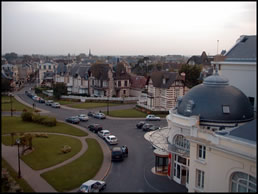 Roadtrip
was the word for today. We traveled nearly 800 km from Heidelberg to the Normandie
region of France. The trip took close to 8 hours with a couple of brief stops
and a 30-minute break for lunch. We are staying at the Grand Hotel de Cabourg,
which is right on the sea. It was gray and damp when we arrived this evening,
but hopefully, over the next couple of days the sun will shine long enough
for us to get a few pictures of the hotel and village. The hotel itself appears
to be quite old, but evokes images of grandeur with long summer days of yore
spent at the beach. It is still a very nice accommodation - 4 *'s by European
standards - we're really anxious to see it in full daylight.
Roadtrip
was the word for today. We traveled nearly 800 km from Heidelberg to the Normandie
region of France. The trip took close to 8 hours with a couple of brief stops
and a 30-minute break for lunch. We are staying at the Grand Hotel de Cabourg,
which is right on the sea. It was gray and damp when we arrived this evening,
but hopefully, over the next couple of days the sun will shine long enough
for us to get a few pictures of the hotel and village. The hotel itself appears
to be quite old, but evokes images of grandeur with long summer days of yore
spent at the beach. It is still a very nice accommodation - 4 *'s by European
standards - we're really anxious to see it in full daylight.
It was after 7:00 in the evening by the time we got settled into our room, and we shortly went out in search of dinner. We settled on an Italian restaurant at the far end of the main street from the hotel. It was your basic Italian fare (pasta and pizza), but it was tasty and reasonable. We're now back in our room with the window open to the cool sea breeze, imaging life at the hotel as it must have been 100 years ago (that's pretty difficult considering we have the lights on, are watching U.S. Open Tennis on TV and are typing on our laptop!)
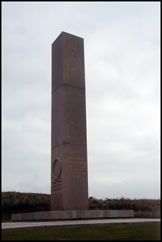 September
12, 2005
September
12, 2005
Our destinations today were the D-Day Beaches - we started at the one
furthest away from our hotel, Utah Beach. The site was nicely maintained,
but unfortunately, unless you paid for admission into the museum or had a
guidebook (we did neither), there wasn't much in terms of an explanation of
the landing of US forces on June 6, 1944 and their subsequent role in the
liberation.
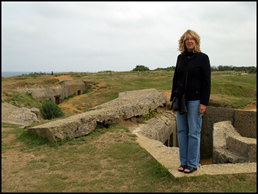 Next,
we made our way to Pointe du Hoc, where the information displays were far
superior. We learned that a group of 225 US Army Rangers was tasked with securing
the point, where the Germans had artillery emplacements and anti-aircraft
weaponry. Unfortunately, due to a navigational error, the assault by the Rangers
was delayed by 40 minutes - it commenced at 07:10, as opposed to 06:30, when
the aerial bombardment ended. As such, the Germans had nearly forty minutes
to regroup and prepare themselves for the offensive. The Army Rangers came
under small arms fire as they attempted to scale the 100-foot cliffs and secure
the position, an objective they achieved at 07:35, but at the cost of 110
casualties. The most dispiriting part of the tale is that once they were over
the top of the cliffs, they found that the German Army had moved nearly all
of their artillery, replacing it with wood beams and camouflage so that the
deception would not be detected by air reconnaissance. The entire area has
been maintained in almost the exact condition as existed on 8 June 1944, when
the Rangers departed, still showing the shattered bunkers and enormous bomb
craters 40 feet in diameter and 20 feet deep.
Next,
we made our way to Pointe du Hoc, where the information displays were far
superior. We learned that a group of 225 US Army Rangers was tasked with securing
the point, where the Germans had artillery emplacements and anti-aircraft
weaponry. Unfortunately, due to a navigational error, the assault by the Rangers
was delayed by 40 minutes - it commenced at 07:10, as opposed to 06:30, when
the aerial bombardment ended. As such, the Germans had nearly forty minutes
to regroup and prepare themselves for the offensive. The Army Rangers came
under small arms fire as they attempted to scale the 100-foot cliffs and secure
the position, an objective they achieved at 07:35, but at the cost of 110
casualties. The most dispiriting part of the tale is that once they were over
the top of the cliffs, they found that the German Army had moved nearly all
of their artillery, replacing it with wood beams and camouflage so that the
deception would not be detected by air reconnaissance. The entire area has
been maintained in almost the exact condition as existed on 8 June 1944, when
the Rangers departed, still showing the shattered bunkers and enormous bomb
craters 40 feet in diameter and 20 feet deep.
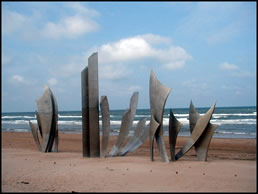
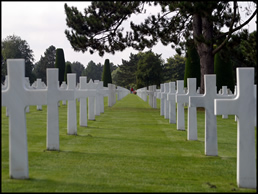 We
continued to drive along Omaha Beach, stopping at several monuments along
the way, until we arrived at the American Cemetery, which overlooks the beachhead.
We stopped at the Visitor's Center to get an information leaflet and started
down the path toward the Memorial. Just before you reach the Memorial, the
Cemetery comes into view on your left. The sight of nearly 10,000 Crosses
and Stars of David literally takes your breath away. I am usually quite emotional
anyway, but that sight brought tears to my eyes and I'm certain that I was
not alone. Simply put, the Cemetery is gorgeous and with its spectacular beach
views, seems an appropriate final resting place for those who gave their lives
on those very shores.
We
continued to drive along Omaha Beach, stopping at several monuments along
the way, until we arrived at the American Cemetery, which overlooks the beachhead.
We stopped at the Visitor's Center to get an information leaflet and started
down the path toward the Memorial. Just before you reach the Memorial, the
Cemetery comes into view on your left. The sight of nearly 10,000 Crosses
and Stars of David literally takes your breath away. I am usually quite emotional
anyway, but that sight brought tears to my eyes and I'm certain that I was
not alone. Simply put, the Cemetery is gorgeous and with its spectacular beach
views, seems an appropriate final resting place for those who gave their lives
on those very shores.  We
both walked among the aisles of headstones - there wasn't much conversation
around us - it is definitely a place to be alone with your thoughts and prayers.
We
both walked among the aisles of headstones - there wasn't much conversation
around us - it is definitely a place to be alone with your thoughts and prayers.
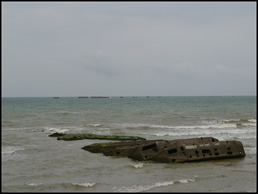 Our
last stop today was Arromanches, where, in June of 1944, the British built
a temporary, floating port, which was the brainchild of Winston Churchill
and was appropriately named Port Winston. To quote from Rick Steve's ("Europe
Through the Backdoor" author) succinct history: "Seventeen old ships
crossed the English Channel under their own steam and were sunk by their crews
bow to stern, to form the first shelter. Then, 115 football-field-size cement
blocks (called Mulberries) were towed across the channel and sunk. This created
a four-mile-long breakwater 1.5 miles off shore — a port the size of
Dover. Then, seven floating steel "pierheads" with extendable legs
were set up and linked to shore by four mile-long floating roads made of concrete
pontoons. Antiaircraft guns were set up on the pontoons. Within six days,
54,000 vehicles, 326,000 troops, and 110,000 tons of goods had been delivered.
An Allied toehold on Normandy was secure. Eleven months later, Hitler was
dead and the war was over."
Our
last stop today was Arromanches, where, in June of 1944, the British built
a temporary, floating port, which was the brainchild of Winston Churchill
and was appropriately named Port Winston. To quote from Rick Steve's ("Europe
Through the Backdoor" author) succinct history: "Seventeen old ships
crossed the English Channel under their own steam and were sunk by their crews
bow to stern, to form the first shelter. Then, 115 football-field-size cement
blocks (called Mulberries) were towed across the channel and sunk. This created
a four-mile-long breakwater 1.5 miles off shore — a port the size of
Dover. Then, seven floating steel "pierheads" with extendable legs
were set up and linked to shore by four mile-long floating roads made of concrete
pontoons. Antiaircraft guns were set up on the pontoons. Within six days,
54,000 vehicles, 326,000 troops, and 110,000 tons of goods had been delivered.
An Allied toehold on Normandy was secure. Eleven months later, Hitler was
dead and the war was over."
The beaches and monuments are spread across a fairly large area of Northwestern France, particularly when you are accessing them by car. So, it was 7:30 by the time we returned to our hotel tonight - and quite the weary tourists we are - mais oui!
September 13, 2005
We visited the Memorial de Caen today. It is essentially a D-day Museum, but
houses several other exhibits as well. The visit to the Museum begins with
a photo-montage of events leading up to WWII from 1917 to the late 1930's.
This is followed by an exhibit hall that details French history, from the
time of the first invasion by German forces and continuing throughout the
occupation. I have to admit that the exhibit made it pretty clear that the
French basically "rolled over" to Germany, with barely a fight.
I don't want this impression to be misleading though, the French lost over
200,000 soldiers and 350,000 civilians during the war and over a million soldiers
were taken as prisoners and shipped to Germany.
The exhibits concerning the D-day invasion were quite good, with maps and models that explained the various forces and their territories of responsibility. To give you some facts about the invasion:
American Troops Taking Part: 73,000 - 23,250 on Utah Beach, 34,250 on Omaha
Beach, and 15,500 airborne troops.
11,590 aircraft were available to support the landings; On D-day, Allied aircraft
flew 14,674 sorties, and 127 aircraft were lost.
By the end of 11 June (D + 5), 326,547 troops, 54,186 vehicles and 104,428
tons of supplies had been landed on the beaches.
The breakdown of US casualties on D-day alone is estimated at 1465 dead, 3184
wounded, 1928 missing and 26 captured.
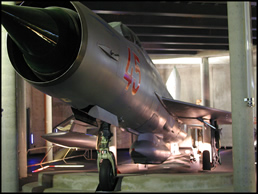 The
numbers are just staggering! The Museum also showed a 35-minute film - the
very wide screen is split to simultaneously show the invasion from the Allies'
perspective on one half and from the Germans' perspective on the other half.
It was very moving, and amazingly, was shown entirely with no narrative.
The
numbers are just staggering! The Museum also showed a 35-minute film - the
very wide screen is split to simultaneously show the invasion from the Allies'
perspective on one half and from the Germans' perspective on the other half.
It was very moving, and amazingly, was shown entirely with no narrative.
We finished our visit with the exhibits concerning the Cold War (complete with a MIG fighter) and after 3.5 hours, decided to skip the last exhibits on "peace".
September 14, 2005
Today we traveled from Normandy to Bruges in Belgium. Our hotel is very
nice and only 2 blocks away from the main attractions at Market Square. After
we checked in, we went out for a short walk through the Market. We stopped
off to share a serving of frites (Freedom Fries) served in traditional fashion
with mayonnaise - we know that you are all scrunching up your faces in disgust,
but you really have to try it at least once (that's with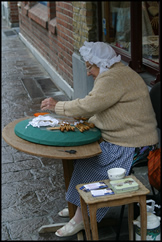
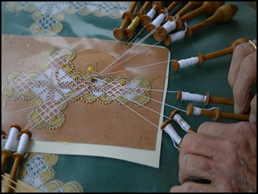 mayonnaise, not Miracle Whip!)- it's really quite good (and this from a Pennsylvania
girl that grew up on Heinz ketchup!).
mayonnaise, not Miracle Whip!)- it's really quite good (and this from a Pennsylvania
girl that grew up on Heinz ketchup!).
We also passed numerous lace shops (Bruges is quite famous for lace-making), and saw an elderly woman sitting in front of one shop, passing her wooden bobbins back and forth to weave lace crosses - what a sight!
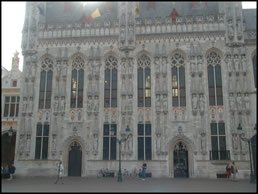 We
ventured out again this evening for dinner and selected a restaurant just
off the "Burg", in view of the Basilica of the Holy Blood. We had
a really nice meal on the terrace and then once again, walked around the old
town. The ancient buildings are lit at night, which really enhances some of
the architectural features of the buildings against the shadows. Bruges is
a very old city, and truly gorgeous, particularly at night. The contrast between
the old and the new is also remarkable - the interior features of restaurants,
shops and apartments (those that you can see into at night) harmoniously blend
ancient stone walls and beams with ultra-modern furnishings. Many of the buildings
have keystones dating from the 1600's - you can imagine that the result is
spectacular.
We
ventured out again this evening for dinner and selected a restaurant just
off the "Burg", in view of the Basilica of the Holy Blood. We had
a really nice meal on the terrace and then once again, walked around the old
town. The ancient buildings are lit at night, which really enhances some of
the architectural features of the buildings against the shadows. Bruges is
a very old city, and truly gorgeous, particularly at night. The contrast between
the old and the new is also remarkable - the interior features of restaurants,
shops and apartments (those that you can see into at night) harmoniously blend
ancient stone walls and beams with ultra-modern furnishings. Many of the buildings
have keystones dating from the 1600's - you can imagine that the result is
spectacular.
September 15, 2005
 We
began our tour of Bruges this morning by visiting the Basilica of the Holy
Blood, famous for its relic of the blood of Christ, which, according to tradition,
was brought to Bruges in 1150 after the Second Crusade. Next door is the gothic
city hall.
We
began our tour of Bruges this morning by visiting the Basilica of the Holy
Blood, famous for its relic of the blood of Christ, which, according to tradition,
was brought to Bruges in 1150 after the Second Crusade. Next door is the gothic
city hall.
We continued on to Market Square with its bell tower built in 1300. We skipped
the 366-step climb to the top as viewing conditions were not that great today,
plus we have "been there, done that". The 47 bells play every quarter
hour and can be heard from just about every corner of the city. 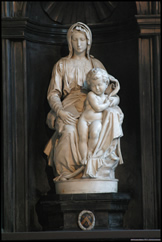 Next,
we strolled along one of the canals to The Church of Our Lady, home to the
Madonna and Child by Michelangelo. It is said to be the only statue of his
to leave Italy in his lifetime (bought with money made from Bruges' lucrative
cloth trade).
Next,
we strolled along one of the canals to The Church of Our Lady, home to the
Madonna and Child by Michelangelo. It is said to be the only statue of his
to leave Italy in his lifetime (bought with money made from Bruges' lucrative
cloth trade).
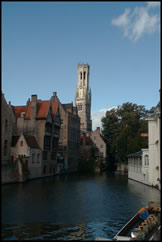 It
was raining by this time so we nipped into a few shops for some souvenirs
and then headed to the nearest pub, which just happened to be Irish! After
our break, armed with umbrellas, we walked through some of the cobbled alleys
and streets that create a labyrinth in the old city. The town was spared bomb
damage in both wars and remains amazingly old world today. The only down-side
is that tourism is the number one industry here, so even off-season (as the
middle of September is), there are loads of tour groups to deal with.
It
was raining by this time so we nipped into a few shops for some souvenirs
and then headed to the nearest pub, which just happened to be Irish! After
our break, armed with umbrellas, we walked through some of the cobbled alleys
and streets that create a labyrinth in the old city. The town was spared bomb
damage in both wars and remains amazingly old world today. The only down-side
is that tourism is the number one industry here, so even off-season (as the
middle of September is), there are loads of tour groups to deal with.
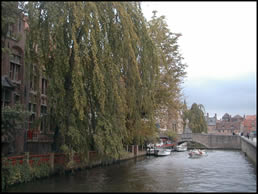 September
16, 2005
September
16, 2005
Happy 9th Birthday Sarah!! We love you!!
After breakfast, we took our bags to the rental car, which we had parked
in an underground garage about 1/4 mile from the hotel. Then, we went to the
post office to begin the process to send a package of souvenirs to the US.
It took us about an hour to buy the box and bubble wrap, get the box packed,
addressed, etc. and take it back to the post office, where we filled out three
different forms for customs purposes. The forms took some time to complete
as the instructions were in Flemish and French - Flemish has some similarities
to German and our French vocabulary is limited to about 6 words (okay, maybe
a few more, but not many!), so between the two languages, we stumbled our
way through. The forms must have been correct, because the lady at the post
office counter didn't yell at us.
We checked out of our hotel and input our destination of Amsterdam into the GPS navigational system - a mere 273 km away. We arrived in Amsterdam at about 3:30 and traffic was horrendous. This actually worked to our advantage because it gave us plenty of time to locate our hotel - and we only had to make one u-turn! We are staying for two nights at the Marriott, right off of the Leidesplein, which is a mass of restaurants and bars and is quite popular with the younger crowd.
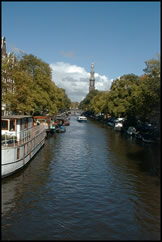 Starting
Sunday, and for the next week, we have rented a houseboat on the Nieuwe Prinsengracht
Canal (for those of you who are following along on your maps). So, we walked
to that section of Amsterdam to check it out. It is situated about a mile
from the hotel, on one of the smaller, quieter canals. It certainly looks
nice from the outside!
Starting
Sunday, and for the next week, we have rented a houseboat on the Nieuwe Prinsengracht
Canal (for those of you who are following along on your maps). So, we walked
to that section of Amsterdam to check it out. It is situated about a mile
from the hotel, on one of the smaller, quieter canals. It certainly looks
nice from the outside!
From the boat, we walked along the Amstel River to the Waterlooplein where we stopped at a small Mexican cafe for a snack of chicken nachos. We headed back in the direction of the hotel via the Rembrandtplein (area heavy with tourists) and Bloemenmarkt (the floating flower market). We will take pictures of these areas and more to include with next week's journal.